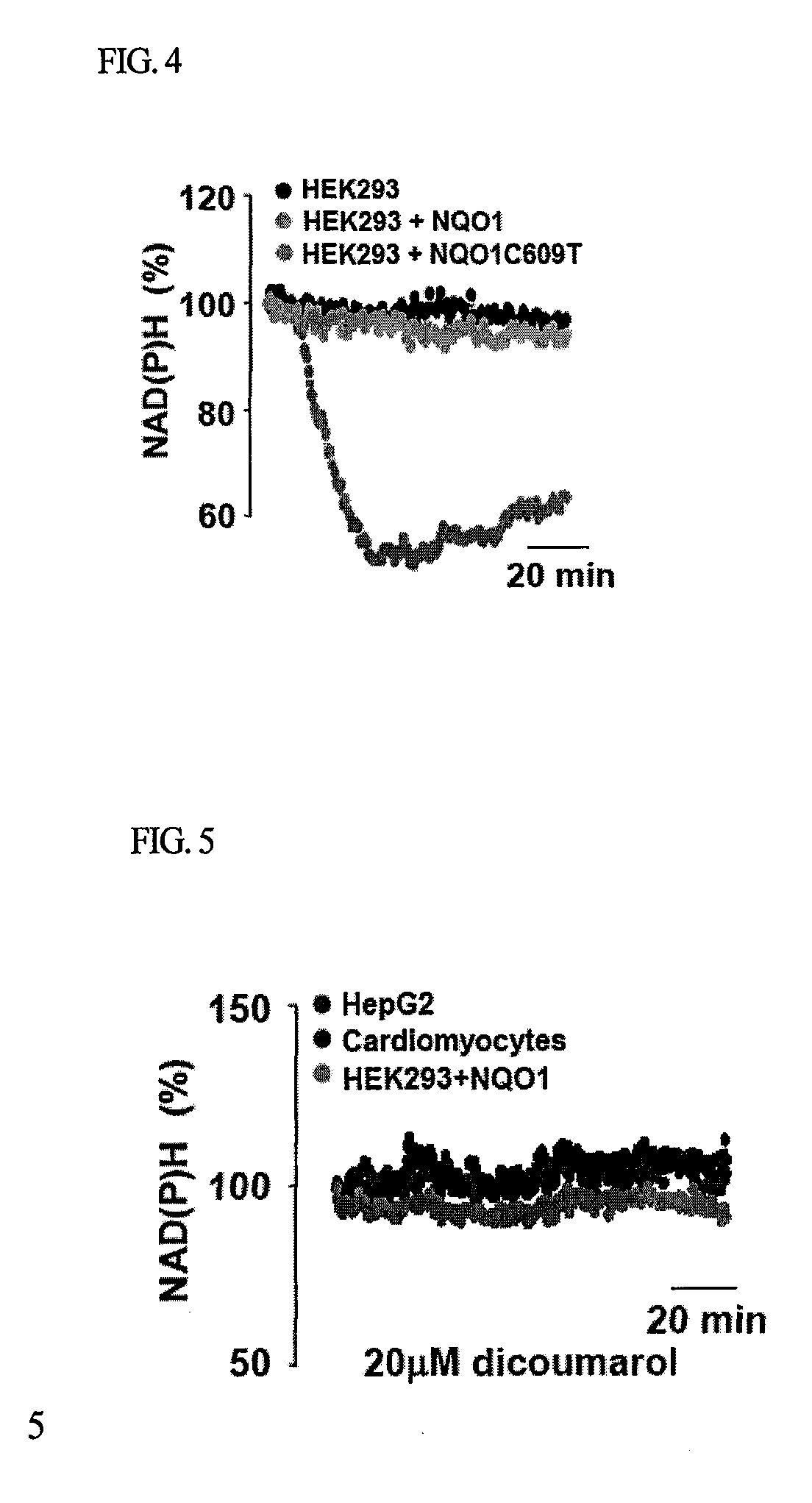Method for controlling nad(p)/nad(p)h ratio by oxidoreductase
a technology of oxidoreductase and nad, which is applied in the direction of peptide/protein ingredients, drug compositions, metabolic disorders, etc., can solve the problems of insufficient glucose supply into cells, manifestation of metabolic syndrome, and no drugs available for the treatment of various diseases resulting from excess energy intake, etc., to promote mitochondrial biogenesis, improve exercise capacity, and increase the active capacity of mitochondria
- Summary
- Abstract
- Description
- Claims
- Application Information
AI Technical Summary
Benefits of technology
Problems solved by technology
Method used
Image
Examples
example 1
Changes in Intracellular NADH Concentration by NQO1 Activator
[0207]This experiment was intended to demonstrate that the reduction of an NQO1 activator, pyrano-1,2-naphthoquinone (hereinafter, often referred to as “βL”), occurs in an NQO1-dependent manner.
[0208]FIG. 1A shows an NQO1 activator concentration-dependent decrease of NADH upon real-time measurement of an intracellular NADH concentration after treatment of the human hepatoma cell line HepG2 having an NQO1 activity with the NQO1 activator pyrano-1,2-naphthoquinone for 2 hours.
[0209]FIG. 1B shows no change in an NADH concentration irrespective of an NQO1 activator concentration and a time period upon real-time measurement of an intracellular NASH concentration while treating HEK293 cells having no NQO1 activity with pyrano-1,2-naphthoquinone for 2 hours.
[0210]FIG. 1C shows an NQO1 activator concentration-dependent decrease of NADH upon real-time measurement of an intracellular NADH concentration while treating the cells with ...
example 2
Changes in Amount and Activity of NQO1 in Tissues of Lean Mice and DIO Mice
[0213]In order to confirm distribution of NQO1 in tissues and cells, various tissues of mice were removed and ultracentrifuged. Using the purified cytosolic fractions, dicoumarol-sensitive NQO1 activity was measured based on differences in reaction rate with / without of 10 μM dicoumarol. An activity value of NQO1 was expressed as the reduced 2,6-dichlorophenolindophenol / min / mg proteins.
[0214]FIG. 6 shows the presence of NQO1 activity in various tissues of Lean and DIO mice. The NQO1 activity was compared between Lean and DIO mouse tissues. As sown in FIG. 6, the NQO1 activity was particularly higher in muscle and liver of DIO mice than Lean mice.
example 3
Changes in Intracellular ATP Concentration by NQO1 Activator
[0215]FIG. 7 shows a sharp decrease in an intracellular ATP concentration of neuronal cells by pyrano-1,2-naphthoquinone. Dopaminergic (MN9D) and non-dopaminergic (MN9X) neuronal cells were treated with 5 μM pyrano-1,2-naphthoquinone and the ATP concentration was periodically measured. As a result the ATP concentration was decreased in MN9D and MN9X cells, and MN9D cells exhibited more sensitive responsiveness to pyrano-1,2-naphthoquinone, as compared to MN9X cells.
PUM
| Property | Measurement | Unit |
|---|---|---|
| Fraction | aaaaa | aaaaa |
| Mass | aaaaa | aaaaa |
| Fraction | aaaaa | aaaaa |
Abstract
Description
Claims
Application Information
 Login to View More
Login to View More - R&D
- Intellectual Property
- Life Sciences
- Materials
- Tech Scout
- Unparalleled Data Quality
- Higher Quality Content
- 60% Fewer Hallucinations
Browse by: Latest US Patents, China's latest patents, Technical Efficacy Thesaurus, Application Domain, Technology Topic, Popular Technical Reports.
© 2025 PatSnap. All rights reserved.Legal|Privacy policy|Modern Slavery Act Transparency Statement|Sitemap|About US| Contact US: help@patsnap.com



